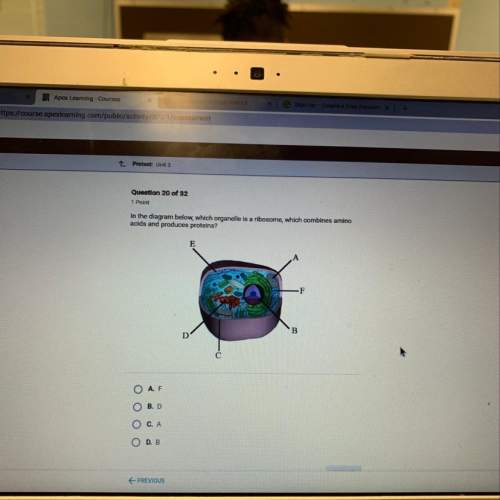
Biology, 24.10.2019 17:43 acervantes29
An animal cell placed in a hypertonic solution will shrink in a process called crenation. an animal cell placed in a hypotonic solution will swell and potentially burst in a process called hemolysis. to prevent crenation or hemolysis, an animal cell must be placed in an isotonic solution such as 0.9% (m/v) nacl or 5.0% (m/v) glucose. this does not mean that a cell has a 5.0% (m/v) glucose concentration; it just means that 5.0% (m/v) glucose will exert the same osmotic pressure as the solution inside the cell, which contains several different solutes. a red blood cell is placed into each of the following solutions. indicate whether crenation, hemolysis, or neither will occur. solution a: 3.21% (m/v) naclsolution b: 1.65% (m/v) glucosesolution c: distilled h2osolution d: 6.97% (m/v) glucosesolution e: 5.0% (m/v) glucose and 0.9%(m/v) nacl

Answers: 1
Another question on Biology

Biology, 21.06.2019 17:30
Charles darwin published his theory of evolution in 1859. in what way foes modern evolutionary theory differ from the theory as proposed by darwin? a) darwin inferred that individuals can evolve, but modern generic science has shown that this is not true. b)darwin inferred that individuals do not evolve, but modern genetic science has shown that this is not true. c)modern science has disproved most of darwin's original theory of evolution, because darwin knew nothing about generations and their role in heredity. d)generic studies have shown that gene expression and other factors operate along with natural selection, but most of darwin's theory has been supported by modern science.
Answers: 1

Biology, 22.06.2019 00:00
An organ system consists of a group of organs that performs specific functions necessary for the survival of an organism. humans have eleven different organ systems: integumentary, skeletal, muscular, nervous, endocrine, circulatory, lymphatic, respiratory, digestive, urinary, and reproductive. discuss the function of neurons, the brain and the spinal cord within the human nervous system while explaining the interrelationship of each organ.
Answers: 1

Biology, 22.06.2019 01:30
15 ! come and answer! a(n) is the general term for an infectious disease that has spread across a city, region, or country.
Answers: 2

Biology, 22.06.2019 22:00
Organ systems are composed of organs, organs are composed of tissues, and tissues are composed of cells. this pattern is organized into levels. organization based on levels can be found in what
Answers: 3
You know the right answer?
An animal cell placed in a hypertonic solution will shrink in a process called crenation. an animal...
Questions


Social Studies, 03.02.2020 09:48

Chemistry, 03.02.2020 09:48

English, 03.02.2020 09:48

Mathematics, 03.02.2020 09:48

Mathematics, 03.02.2020 09:48

Physics, 03.02.2020 09:48



Mathematics, 03.02.2020 09:48

Mathematics, 03.02.2020 09:48

History, 03.02.2020 09:48




Health, 03.02.2020 09:48


Chemistry, 03.02.2020 09:48

Biology, 03.02.2020 09:48

Mathematics, 03.02.2020 09:48




